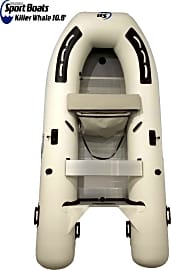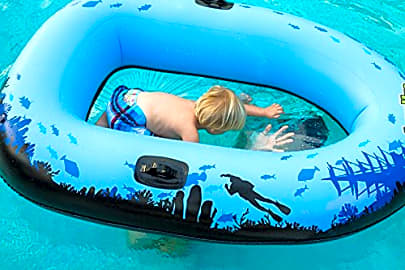The 9 Best Inflatable Boats

This wiki has been updated 43 times since it was first published in March of 2015. Whether you're fishing on the lake, ferrying supplies from shore to your mega yacht, or enjoying a day at the beach with your family, one of these inflatable rafts and boats will be perfect for the job. They vary in size, weight, and price, but they've all got one thing in common: they're made to be simple to use, which means you won't need a degree in rocket science to assemble or pilot them. When users buy our independently chosen editorial recommendations, we may earn commissions to help fund the Wiki.
Editor's Notes
February 26, 2021:
First of all, with any of these, proper maintenance is of prime importance; because these rely on seams and general body integrity to float at all, you'll need to take special care of an inflatable boat that other watercraft don't require.
With that out of the way, there are a couple types of inflatable boat to choose from. The most familiar is the common raft, which can have a softbottom like the affordable Intex Challenger 2 and Intex Mariner 4, and the mid-range Airhead Angler Bay do, or they can have a rigid floor that significantly increases stability. In fact, it's worth mentioning that if you plan on fishing in a raft, you might consider focusing on those with aluminum bottoms, because soft-bottom rafts can get a little dodgy under the weight of a bunch of gear.
If you are looking for something nice with a rigid floor, the Newport Dana is it, and it comes in a few sizes to suit specific needs. It can also accommodate a 10-horsepower outboard motor and move safely at up to 20 miles per hour. The Sport Boats Killer Whale is every bit as high-quality, and is a touch less expensive, to boot.
Alternatively, solo fishers will love the Classic Accessories Colorado XT, which is outfitted with plenty of easy-to-reach storage space, multi-position oar sockets, and the stability that basically only comes with a one-person inflatable pontoon boat.
April 16, 2019:
While it's true that inflatable boats can be safe, we just want to remind users that these craft have limitations that should be heeded (usually spelled out in the manufacturer's instructions) and require ongoing inspections to ensure their usability over time. Having said this, we still believe that the Classic Accessories Colorado XT and Sport Boats Killer Whale are fine options. The former is geared toward fishers and has just about all the features you could ask for, from foot rests to a six-position rod holder. It's also surprisingly affordable for the durability and complexity. The Killer Whale is on the more expensive side, a true investment, but if you spend a lot of time out on the water, it'll give you the usage you're looking for along with a hull identification number to make registration easier.
For those looking for less expensive options, we suggest the Airhead Angler Bay, Intex Mariner 4, or the Intex Challenger 2. In fact, the Challenger 2 is probably one of the lowest-priced models you'll find that's still appropriate for more than just a backyard pool. Finally, we decided to add the Classic Accessories Cumberland, which is a belly boat made for fishing, one that is roomy and can hold up to 350 pounds.
Special Honors
Stryker Boats Not only does this high-end manufacturer have several tiers of quality inflatables to choose from, if none of those fulfill your needs, they even let you customize the size, transom height, hull thickness, color, and accessories of the perfect rigid-hull inflatable boat for you. While none of their products are particularly budget-friendly, you can be certain that they last longer and are more full-featured than most others brands'. strykerboats.com
A Rubber Band Of Brothers
One person cannot drag ashore 565 pounds of motorized, vulcanized rubber with a maximum payload of 1.4 tons designed to ferry Death itself across the River Styx.
Originally made from vulcanized rubber, modern inflatable boats for civilians are now typically made with PVC or vinyl. Although not nearly as puncture-resistant as vulcanized rubber, the standard for search-and-rescue missions and special operations, PVC and vinyl are much more flexible and lightweight.
For example, let's compare the Navy SEALs' "Zodiac", a rubber assault raft, with your average vinyl inflatable dinghy for fishing on the nearest lake. The former is designed for beyond-the-horizon transportation, stealth, and its ability to take a bullet in one or more of its eight distinct air chambers and remain afloat. The latter, with its average of three or four air chambers, is designed to not sink completely if you accidentally poke a hole in it with a fishing hook.
One person can drag ashore a PVC or vinyl boat, complete with tackle box and a cooler full of fish. One person cannot drag ashore 565 pounds of motorized, vulcanized rubber with a maximum payload of 1.4 tons designed to ferry Death itself across the River Styx.
In other words, vulcanized rubber may indeed be stronger than both PVC and vinyl put together, but it's also much heavier, which completely defeats the purpose of owning an inflatable boat to begin with.
Indeed, why buy an inflatable boat if you can't take it out by yourself from time to time?
To Hull And Back Again
We've talked about the benefits of PVC and vinyl for those of us not running black ops in the Persian Gulf. Now let's talk a bit about the different kinds of hulls you might come across and the effects they may have on how and where you decide to use your inflatable boat.
Inflatable boats have three major types of hulls:
Flexible hulls with flexible floors for small boats less than three meters long allow for the most compact storage of all of the inflatable boats.
Flexible hulls with flexible floors for small boats less than three meters long allow for the most compact storage of all of the inflatable boats. Flexible hulls allow you to deflate your boat, fold, roll it, and stuff it into a carry bag sometimes small enough to fit inside a larger bag, such as a camping backpack. They are typically made of the same material as the rest of the boat. Most whitewater rafts have flexible hulls designed to bend to the will of the rocks.
Flexible hulls with rigid floors allow for sturdier boats while affording some flexibility for mounting waves. The floors usually consist of a handful of plywood or aluminum slats designed to prevent the boat from squeezing without sacrificing the benefits of bending bow to stern.
Rigid Inflatable Boats (RIBs) have hard, V-shaped hulls that allow them to navigate rougher waters, such as the open sea, with increased maneuverability and control. RIBs make for ideal search-and-rescue boats because not only can they cut through waves with ease, but their inflatable gunwale ensures the boat stays afloat in the event it takes on too much water during a mission.
In sum, don't take plywood floors whitewater rafting and don't take flexible floors on a rescue mission. The rest is up to you.
Rubber Ducky, You're Not The Only One
Anyone who has ever floated down a river on an inner tube will probably not be the least bit surprised to learn that the modern inflatable boat began with none other than Charles Goodyear, the chemist and engineer after whom Frank Seiberling named his famous tire company.
In 1838, approximately 2,500 years after Mesoamericans invented stabilized rubber to make balls for sport, Goodyear invented his own more sophisticated process for curing rubber called vulcanization, named after Vulcan, the Roman god of fire.
Not only could it be carried in a knapsack, but it doubled as a waterproof blanket for explorers caught camping on wet ground.
Over the years, thanks to its amazing properties, vulcanized rubber has provided us with all sorts of rubbery inventions that we often take for granted, such as shoe soles, conveyor belts, rubber duckies and squeaky dog toys. But before shopping cart wheels drove us utterly insane with their uncanny ability to veer to the left at the most inopportune moments, vulcanized rubber gave the United Kingdom's Royal Navy its very first inflatable boat, the Halkett boat.
Designed in 1845 by Lieutenant Peter Halkett, the Halkett boat was a step up from the Duke of Wellington's inflatable pontoons. Not only could it be carried in a knapsack, but it doubled as a waterproof blanket for explorers caught camping on wet ground. However, despite the boat's many features, the Admiralty deemed the boat unfit for general use in the Royal Navy and limited its use to survey expeditions. It was not until the Titanic sunk in 1912 that everyone, including the Royal Navy, began to take inflatable boats very seriously.
Since then, inflatable boats have become not only the standard for lifeboats, replacing the Titanic's fancy wooden clunkers, but also the standard for military assault rafts, giving us the Combat Rubber Reconnaissance Craft, the aptly nicknamed "Zodiac" that Hollywood directors love to feature in their war films.
Best of all, now you can have one, too. And you don't need to use it for invading exotic lands, if you don't want to.














